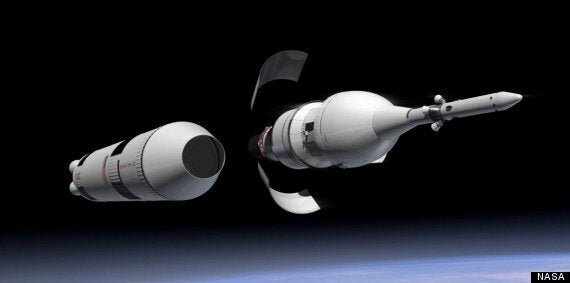A NASA video designed to promote the Orion space craft has accidentally whipped up Moon Landing Hoax theorists into a frenzy.
Which is a shame. Because the 'Orion: Trial By Fire' video is actually an interesting, if brief introduction into the test flights.
Presented by NASA engineer Kelly Smith, the video contains insights into how Orion might help humans get to Mars and how its systems are designed to cope with the difficulties of travelling in deep space.
But it also describes how the capsule will be lifted from an initial orbiting trajectory of around 100 miles above Earth, to more than 3,600 miles before the end of the mission.
And therein lies the issue. Because the aim of this test is to send Orion through the Van Allen belt -- a thick ribbon of dense radioactive particles caused by the magnetic field of Earth which could be dangerous to human travellers.
"Radiation like this could harm the guidance systems, on-board computers or other electronics on Orion," Smith says. "Shielding will be put to the test as the vehicle cuts through the waves of radiation… We must solve these challenges before we send people through this region of space."
Aha! And that's where the conspiracy theorists jump in. Because surely, they argue, NASA already sent people through this region for the Apollo missions to the Moon in the 1960s and 1970s?

So... hoax proved? Half-Life 3 confirmed?
One writes: "The way this video was explained is that just passing the Van Allen belt and coming back to earth is a very serious mission… If it were true, we should at least have landed on Mars by now and flown manned flights to one of Mars' moons or even a fly by of Saturn or Jupiter."
Another adds: "Didn't NASA go to the moon? With very little shielding? Aren't you guys basically saying you didn't land on the moon? "
Yet another (there are lots of these people) says: "If the moon missions were real, then it seems the whole "punching through the Van Allen belt" problem should have been solved over 40 years ago."
So? So, so? Can NASA explain that?
Yes. Yes they can.
The answer, simply, and which has been explained in detail elsewhere, is that the Apollo astronauts were not in the Van Allen belt for long enough to have to deal with dangerous levels of exposure to radiation.
The Apollo astronauts did return to Earth having been exposed to significant radiation - but not more than is allowed by US law for workers at nuclear power stations, for instance.
So what's different with Orion EFT-1? Put simply, two things: equipment and time.

Above: Orion pictures in a computer-generated image separating above Earth, before heading up to the Van Allen belt
First, Orion contains much more complex and complicated electronic equipment than the Apollo systems, which could potentially be damaged by radiation and so has to be tested before humans are allowed to fly inside it.
Second, Orion isn't just intended to go through the Van Allen belt and back in a few short days. It's designed for missions up to 21 days long, and perhaps even longer if it forms part of a mission to Mars. As a result it would face exposure to vast amounts of radiation in space, for months on end, and so testing its shields and how much radiation gets through is prooobably a good idea.
So no, NASA did not accidentally leak that the Apollo missions were fake in its own promotional videos.
"Traveling 15 times farther into space than the International Space Station will take Orion beyond the radiation protection offered by Earth’s atmosphere and magnetic field. In fact, the majority of EFT-1 will take place inside the Van Allen Belts, clouds of heavy radiation that surround Earth.
No spacecraft built for humans has passed through the Van Allen Belts since the Apollo missions, and even those only passed through the belts – they didn’t linger.
Future crews don’t plan to spend more time than necessary inside the Van Allen Belts, either, but long missions to deep space will expose them to more radiation than astronauts have ever dealt with before. EFT-1’s extended stay in the Van Allen Belts offers a unique opportunity to see how Orion’s shielding will hold up to it. Sensors will record the peak radiation seen during the flight, as well as radiation levels throughout the flight, which can be mapped back to geographic hot spots."
Next.